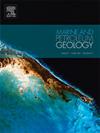与超块体搬运沉积地形相关的浊积砂充填调节:阿根廷西部露头例子
IF 3.7
2区 地球科学
Q1 GEOSCIENCES, MULTIDISCIPLINARY
引用次数: 0
摘要
块体搬运沉积(MTDs)在其上表面产生地形起伏。地形特征的尺度和几何形状及其沉积物填充物的相互联系对确定伴生浊积岩储层的特征起着至关重要的作用。浊积砂可能沉积在由超mtd地形形成的孤立沉积中心中。池状砂、孤立砂或弯曲互连砂的间距和最大厚度受地表地形的主要地形波长和振幅控制。一旦地形被填满到鞍(相邻地形低洼之间的最低点),砂体就会形成一个连续的片状物,上面点缀着标记出高度(nunataks)的凹穴(“洞”)。阿根廷西部Cerro Bola 200米厚MTD上的密闭浊积物说明了这一点。现场资料将水池浊积岩划分为a)欠填段;受短波长(数十至数百米)地形限制的孤立且横向多变的砂层。较厚地层的对比表明,较大的水流至少能够越过地形上的鞍状地带,而在每个低洼处只有一小部分水流被捕获。b)过填充段;由一个横向连续的砂层组成,覆盖短波长地形,同时逐渐叠加长波(千米尺度)特征。沉积相可以帮助区分封闭/池塘阶段,其中局部地形仍然出现,从而表明整体连通性。本文章由计算机程序翻译,如有差异,请以英文原文为准。
Turbidite sands filling accommodation associated with supra-mass transport deposit topography: Outcrop examples from Western Argentina
Mass transport deposits (MTDs) generate topographic relief on their upper surfaces. The scale and geometry of the topographic features, and the interconnectivity of their sediment fill plays a crucial role in defining the characteristics of associated turbidite reservoirs. Turbidite sands may be ponded in isolated depocenters created by supra-MTD topography. The spacing and maximum thickness of ponded and isolated or tortuously interconnected sands are controlled by the dominant topographic wavelength and amplitude on the surface topography. Once the topography is filled to the saddles (the lowest point between adjacent topographic lows), the sand body forms a continuous sheet peppered with lacunae (‘holes’) marking the emergent heights (‘nunataks’). This is illustrated by confined turbidites over a 200-m thick MTD at Cerro Bola, Western Argentina. Field data differentiate ponded turbidites into a) Underfilled section; an isolated and laterally variable sand interval, confined by short-wavelength (tens to hundreds of meters) topography. Correlation of thicker beds suggests that larger flows were able to over-run at least the saddles in the topography, with only a small portion of the flow being captured in each low. b) Overfilled section; consists of a laterally continuous sand interval that covers the short-wavelength topography while progressively onlapping longer-wavelength (km-scale) features. Depositional facies may help to differentiate the confined/ponded stages, where local topography is still emergent, and thus to indicate the overall connectivity.
求助全文
通过发布文献求助,成功后即可免费获取论文全文。
去求助
来源期刊

Marine and Petroleum Geology
地学-地球科学综合
CiteScore
8.80
自引率
14.30%
发文量
475
审稿时长
63 days
期刊介绍:
Marine and Petroleum Geology is the pre-eminent international forum for the exchange of multidisciplinary concepts, interpretations and techniques for all concerned with marine and petroleum geology in industry, government and academia. Rapid bimonthly publication allows early communications of papers or short communications to the geoscience community.
Marine and Petroleum Geology is essential reading for geologists, geophysicists and explorationists in industry, government and academia working in the following areas: marine geology; basin analysis and evaluation; organic geochemistry; reserve/resource estimation; seismic stratigraphy; thermal models of basic evolution; sedimentary geology; continental margins; geophysical interpretation; structural geology/tectonics; formation evaluation techniques; well logging.
 求助内容:
求助内容: 应助结果提醒方式:
应助结果提醒方式:


